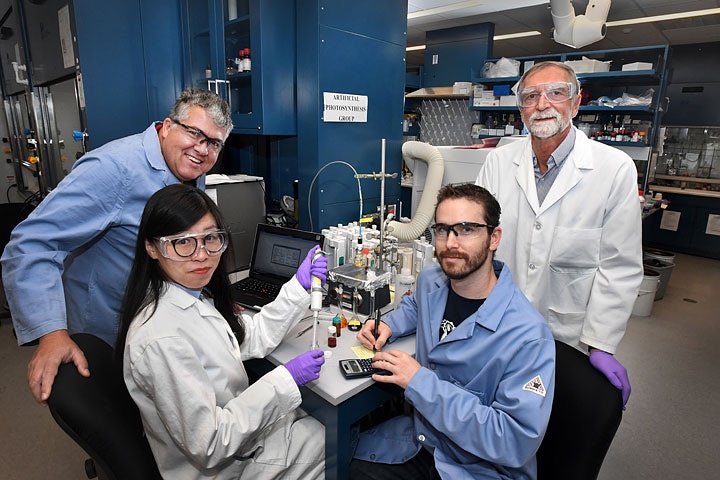Oct 4 2017
Chemists at the U.S. Department of Energy’s Brookhaven National Laboratory have developed a new catalyst that accelerates the rate of a main step in “artificial photosynthesis”—an effort to imitate how algae, plants and certain bacteria harness sunlight to change water and carbon dioxide into energy-rich fuels. This step—known as water oxidation—discharges electrons and protons from water molecules, generating oxygen as a byproduct.
 Research team leader Javier Concepcion (standing, left) with Yan Xie, David Shaffer, and David Szalda(CREDIT: Brookhaven National Laboratory)
Research team leader Javier Concepcion (standing, left) with Yan Xie, David Shaffer, and David Szalda(CREDIT: Brookhaven National Laboratory)
This “single-site” catalyst—meaning the whole reaction sequence occurs on a single catalytic site of one molecule—is the first to meet the efficiency of the catalytic sites that drive this reaction in nature. The single-site design and high efficiency significantly enhance the potential for making successful solar-to-fuel conversion devices.
“The end goal is to break out those molecular building blocks—the protons and electrons—to make fuels such as hydrogen,” said David Shaffer, a Brookhaven research associate and lead author on a paper describing the work in the Journal of the American Chemical Society. “The more efficient the water oxidation cycle is, the more energy we can store.”
But splitting water molecules isnot easy.
Water is very stable. Water can undergo many boiling/condensing cycles and it stays as H2O. To get the protons and electrons out, we need to make the water molecules react with each other.
Javier Concepcion, Chemist, Brookhaven and Leader of the Research
The catalyst serves as a chemical handler, shuffling around the water molecules’ assets—hydrogen ions (protons), electrons and oxygen atoms—to make the reaction happen.
The new catalyst design improves on one the team created last year, led by Graduate Student Yan Xie, which was also a single-site catalyst, with all the components required for the reaction on a single molecule. This method is appealing because the Researchers can enhance how the numerous parts are arranged so that reacting molecules unite in just the right way.
Such catalysts do not rely on the free diffusion of molecules in a solution to attain reactions, so they tend to continue working even when fixed to a surface, as they would be in real-world devices.
We used computer modeling to study the reactions at the theoretical level to help us design our molecules. From the calculations we have an idea of what will work or not, which saves time before we get into the lab.
Javier Concepcion, Chemist, Brookhaven and Leader of the Research
In both Xie’s design and the new enhancement, there is a metal at the center of the molecule, enclosed by other components the Researchers can select to give the catalyst specific properties. The reaction begins by oxidizing the metal, which pulls electrons away from the oxygen on a water molecule. That causes a “positively charged” or “activated” oxygen and two positively charged hydrogens (protons) to be left behind.
“Taking electrons away makes the protons easier to release. But you need those protons to go somewhere. And it’s more efficient if you remove the electrons and protons at the same time to prevent the build-up of excess charges,” Concepcion said. “So Xie added phosphonate groups as ligands on the metal to act as a base that would accept those protons,” he explained. Those phosphonate groups also made it easier to oxidize the metal to eliminate the electrons in the first place.
However a problem still persists. In order to trigger the H2O molecule, one first needs it to bind to the metal atom at the catalyst’s center.
In the first design, the phosphonate groups were so robustly bound to the metal that they were stopping the water molecule from binding to the catalyst early enough to keep the process running effortlessly. That decelerated the catalytic cycle.
So the team made a switch. They kept one phosphonate group to serve as the base, but traded out the other for a less-strongly-bound carboxylate.
“The carboxylate group can more easily adjust its coordination to the metal center to allow the water molecule to come in and react at an earlier stage,” Shaffer said.
When we are trying to design better catalysts, we first try to figure out what is the slowest step. Then we redesign the catalyst to make that step faster. Yan’s work made one step faster, and that made one of the other steps end up being the slowest step. So in the current work we accelerated that second step while keeping the first one fast.
David Shaffer, Research Associate, Brookhaven National Laboratory
The enhancement transformed a catalyst that developed two or three oxygen molecules per second to one that creates over 100 per second—with a corresponding increase in the creation of electrons and protons that can be used to make hydrogen fuel.
“That’s a rate that is comparable to the rate of this reaction in natural photosynthesis, per catalytic site,” Concepcion said. “The natural photosynthesis catalyst has four metal centers and ours only has one,” he explained. “But the natural system is very complex with thousands and thousands of atoms. It would be extremely hard to replicate something like that in the lab. This is a single molecule and it does the same function as that very complex system.”
The following step is to analyze the new catalyst in devices integrating electrodes and other components for converting the electrons and protons to hydrogen fuel—and then later, with light-absorbing compounds to deliver energy to drive the entire reaction.
“We have now systems that are working quite well, so we are very hopeful,” Concepcion said.
The DOE Office of Science supports this study.
Bubbles producing oxygen when catalyst is added to the solution
Bubbles indicate the rapid production of oxygen (O2) when the catalyst is added to the solution. For each O2 molecule produced, four protons (H+) and four electrons are released—enough to make two hydrogen (H2) molecules. (CREDIT: Brookhaven National Laboratory)